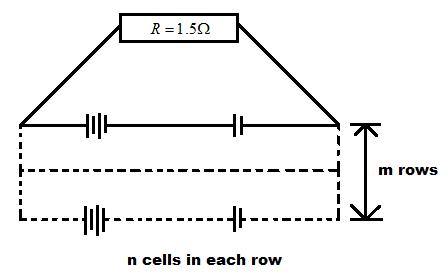
12 cells, each of emf $1.5{\text{V}}$ and internal resistance $0.5\Omega $.are arranged in ${\text{m}}$ rows each containing $'{\text{n'}}$ cells connected in series, as shown. Calculate the values of $'{\text{n'}}$ and ${\text{'m'}}$ for which this combination would send maximum current through an external resistance of $1.5\Omega $.

Answer
135k+ views
Hint: In this question, we are having $12$ cells and each cell is having $15{\text{V}}$emf. There are ${\text{m}}$ number of rows and each row is having ${\text{n}}$ cells in each row that are connected in the series. The load resistance is equal to $1.5\Omega $. First, we find the ${R_{{\text{internal}}}}$ by using the resistance in series and parallel formulas and putting it into load resistance and find the value of ${\text{n}}$ and ${\text{m}}$.
Formula used:
Resistance in the series is written as;
${R_s} = {R_1} + {R_2} + .......$
Resistance in parallel is written as;
$\dfrac{1}{{{R_p}}} = \dfrac{1}{{{R_1}}} + \dfrac{1}{{{R_2}}} + ......$
Complete step by step solution:
Here we can write the load resistance as;
${R_{{\text{load}}}} = {R_{{\text{internal}}}} - - - - (1)$
Now here we are having ${\text{n}}$ number of resistances in series so we can write it as,
${R_s} = nr$
Here we take $r$ for resistance in series because we are not getting any confusion.
And we have ${\text{m}}$ a number of resistance parallel formation.
Therefore, we can write internal resistance as,
${R_{{\text{internal}}}} = \dfrac{{{\text{n}}r}}{{\text{m}}}$
Now put this value in the equation $(1)$ we get;
${R_{{\text{load}}}} = \dfrac{{{\text{n}}r}}{{\text{m}}} - - - - (2)$
Here we have, $r = 0.5\Omega ,{R_{{\text{load}}}} = 1.5\Omega $, putting these values in the equation $(2)$ we get;
$1.5 = \dfrac{{\text{n}}}{{\text{m}}} \times 0.5 \\
\Rightarrow \dfrac{{\text{n}}}{{\text{m}}} = \dfrac{{1.5}}{{0.5}} \\
\Rightarrow \dfrac{{\text{n}}}{{\text{m}}} = 3 - - - - (3) \\
$
Now, we have total cells is,
$
{\text{n}} \times {\text{m = }}12 \\
\Rightarrow {\text{nm = }}12 - - - (4) \\
$
Dividing equation $(3)$ by the equation $(4)$ we get;
$
\dfrac{{\text{n}}}{{{\text{n}}{{\text{m}}^2}}} = \dfrac{3}{{12}} \\
\Rightarrow \dfrac{1}{{{{\text{m}}^2}}} = \dfrac{1}{4} \\
\Rightarrow {{\text{m}}^2} = 4 \\
\Rightarrow {\text{m = 2}} \\
$
Now, put this value of ${\text{m}}$ in the equation $(4)$ we get;
$
{\text{nm = 12}} \\
\Rightarrow {\text{n = }}\dfrac{{12}}{2} \\
\Rightarrow {\text{n = 6}} $
Hence there are $6$ cells in series and $2$ cells are parallel.
Hence, the value of ${\text{n = 6}}$ and ${\text{m = 2}}$.
Note: Do not confuse the formulas of series and parallel formation of resistance, they both have different formulas. If the resistances are connected in series then the overall resistance of the combination equals the sum of the resistance of each resistor and in case of parallel condition the overall resistance is less than the resistance of each resistor.
Formula used:
Resistance in the series is written as;
${R_s} = {R_1} + {R_2} + .......$
Resistance in parallel is written as;
$\dfrac{1}{{{R_p}}} = \dfrac{1}{{{R_1}}} + \dfrac{1}{{{R_2}}} + ......$
Complete step by step solution:
Here we can write the load resistance as;
${R_{{\text{load}}}} = {R_{{\text{internal}}}} - - - - (1)$
Now here we are having ${\text{n}}$ number of resistances in series so we can write it as,
${R_s} = nr$
Here we take $r$ for resistance in series because we are not getting any confusion.
And we have ${\text{m}}$ a number of resistance parallel formation.
Therefore, we can write internal resistance as,
${R_{{\text{internal}}}} = \dfrac{{{\text{n}}r}}{{\text{m}}}$
Now put this value in the equation $(1)$ we get;
${R_{{\text{load}}}} = \dfrac{{{\text{n}}r}}{{\text{m}}} - - - - (2)$
Here we have, $r = 0.5\Omega ,{R_{{\text{load}}}} = 1.5\Omega $, putting these values in the equation $(2)$ we get;
$1.5 = \dfrac{{\text{n}}}{{\text{m}}} \times 0.5 \\
\Rightarrow \dfrac{{\text{n}}}{{\text{m}}} = \dfrac{{1.5}}{{0.5}} \\
\Rightarrow \dfrac{{\text{n}}}{{\text{m}}} = 3 - - - - (3) \\
$
Now, we have total cells is,
$
{\text{n}} \times {\text{m = }}12 \\
\Rightarrow {\text{nm = }}12 - - - (4) \\
$
Dividing equation $(3)$ by the equation $(4)$ we get;
$
\dfrac{{\text{n}}}{{{\text{n}}{{\text{m}}^2}}} = \dfrac{3}{{12}} \\
\Rightarrow \dfrac{1}{{{{\text{m}}^2}}} = \dfrac{1}{4} \\
\Rightarrow {{\text{m}}^2} = 4 \\
\Rightarrow {\text{m = 2}} \\
$
Now, put this value of ${\text{m}}$ in the equation $(4)$ we get;
$
{\text{nm = 12}} \\
\Rightarrow {\text{n = }}\dfrac{{12}}{2} \\
\Rightarrow {\text{n = 6}} $
Hence there are $6$ cells in series and $2$ cells are parallel.
Hence, the value of ${\text{n = 6}}$ and ${\text{m = 2}}$.
Note: Do not confuse the formulas of series and parallel formation of resistance, they both have different formulas. If the resistances are connected in series then the overall resistance of the combination equals the sum of the resistance of each resistor and in case of parallel condition the overall resistance is less than the resistance of each resistor.
Recently Updated Pages
JEE Main 2021 July 25 Shift 2 Question Paper with Answer Key

JEE Main 2021 July 25 Shift 1 Question Paper with Answer Key

JEE Main 2021 July 20 Shift 2 Question Paper with Answer Key

JEE Main 2021 July 22 Shift 2 Question Paper with Answer Key

How to find Oxidation Number - Important Concepts for JEE

Half-Life of Order Reactions - Important Concepts and Tips for JEE

Trending doubts
JEE Main 2025 Session 2: Application Form (Out), Exam Dates (Released), Eligibility, & More

JEE Main 2025: Derivation of Equation of Trajectory in Physics

Degree of Dissociation and Its Formula With Solved Example for JEE

Electric field due to uniformly charged sphere class 12 physics JEE_Main

Electric Field Due to Uniformly Charged Ring for JEE Main 2025 - Formula and Derivation

Elastic Collisions in One Dimension - JEE Important Topic

Other Pages
JEE Advanced Marks vs Ranks 2025: Understanding Category-wise Qualifying Marks and Previous Year Cut-offs

Dual Nature of Radiation and Matter Class 12 Notes: CBSE Physics Chapter 11

Displacement-Time Graph and Velocity-Time Graph for JEE

Formula for number of images formed by two plane mirrors class 12 physics JEE_Main

JEE Advanced 2024 Syllabus Weightage

JEE Main Chemistry Question Paper with Answer Keys and Solutions




